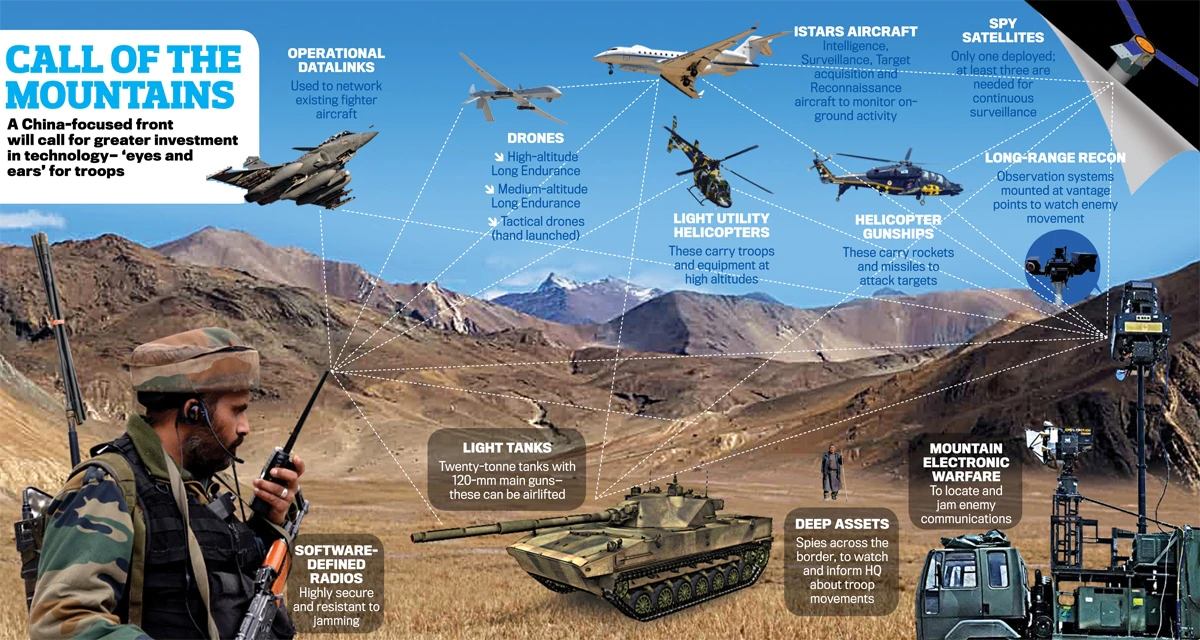
SOURCE: INDIA TODAY
Five years ago, a committee of experts appointed to recommend reforms for the archaic defence ministry forecast the future conflicts the Indian armed forces would likely be involved in. Headed by Lt General D.B. Shekatkar, former Director General Military Operations, the committee said that future wars would likely break out in the mountains, where all of India’s contested borders with China and Pakistan lay, and that they would, in all probability, remain confined there. It estimated a low probability of conflict spilling out into the plains.
That prediction might have sounded prescient in May, as a series of events brought India and China closer to conflict than at any other point in over three decades. In response to the Chinese People’s Liberation Army’s (PLA’s) largest military deployment along the disputed Line of Actual Control (LAC) since the 1962 war, India surged two infantry divisions forward into Ladakh, backed by tanks, helicopter gunships and fighter jets. The bloody June 15 clashes, in which 20 Indian soldiers and an unknown number of their Chinese counterparts were killed, brought the two countries to the brink of war. It took a series of marathon meetings between the Indian and Chinese commanders to de-escalate, leading to the both sides stepping back from four ‘friction points’.
A statement issued by the Indian Army after the fourth meeting, on July 14, said that both sides ‘remained committed to the objective of complete disengagement’, or pulling back from the friction points, particularly at Pangong Tso where the Indian Army wants the PLA to go back to ‘Finger 8’ from ‘Finger 5’, where it currently is. It took the army two days to issue this carefully-worded statement, and perhaps to find measured words to hide its disappointment over the lack of a breakthrough.
Privately, army officers admit to trust issues, saying there are doubts over whether the PLA will de-escalate, or send its troops back to their barracks in Xinjiang in a hurry. This could mean that four of the army’s divisions, over 60,000 soldiers, will likely be deployed through the winter, from September to March. What complicates matters is that this deployment is at altitudes ranging from 11,000 feet to 16,000 feet, and would be among the army’s largest and most prolonged high-altitude deployments. In fact, the entire LAC, over 4,000 kilometres, facing China is now active. Over 200,000 soldiers are on alert in a Himalayan swathe extending from the oxygen-deficient post of Daulat Beg Oldie in Ladakh to the emerald green forests of Kibithu at the easternmost edge of Arunachal Pradesh.
“China has shown that it will not be bound by previous boundary agreements, and hence, we have to be ever-vigilant,” says Lt Gen. Shekatkar. “The next surprise could come in Sikkim or in Arunachal Pradesh.” Lest it be surprised again, New Delhi is contemplating its biggest reset to its China policy in decades, reaching out to like-minded democracies across the world to deal with a belligerent Beijing.
The army’s immediate focus is to ensure that its soldiers are adequately equipped. The government has sanctioned emergency funds to make up the shortfall in rockets, ammunition, bombs and missiles. However, weapons make up only a part of the required kit, also being procured are extreme-weather gear, such as three-layered ‘extreme cold climate’ clothing, which protects soldiers from -50 degree temperatures, and 10-person Arctic tents to house soldiers on the heights. The Leh-based 14 Corps has also commenced its winter stockpiling, particularly of diesel and kerosene, to ensure that the additional troops are well supplied.
Meeting the requirements of this enormous troop deployment would not be possible without road access. This can become a serious problem, because heavy snowfall cuts off the only two access points to Jammu and Kashmir, the Zojilla Pass, which links the Valley to Jammu, and the Rohtang Pass, which connects Himachal Pradesh to Ladakh, for six months of the year. On this count, the 8.8 km strategic ‘Atal tunnel’ in Himachal Pradesh, that links Manali with Leh, is to be opened this September, and the Border Roads Organisation is working to ensure that the full length of the road remains open through the winter so that the Ladakh garrison remains provisioned at all times.
The Winter War
In the long term, the Indian armed forces’ focus will extend to providing soldiers with equipment specifically designed for fighting in the mountains. This ranges from light helicopters and gunships to drones and electronic warfare systems designed to operate at the rarefied heights (see Call of the Mountains).
The Himalayas, the world’s highest mountain ranges, with an average elevation of 20,000 feet, are among the harshest terrain any military can be deployed in, imposing severe restrictions on both personnel and equipment. The air is thin, and hence, the sunshine is far more intense. Temperatures can drop to as low as -50 degrees centigrade. This poses serious challenges for machinery, lead-acid batteries stop working at -10 degrees, and the rubber pipes in engines that connect fuel tanks become brittle at -20 degrees. Radar performance is degraded by the dense clutter of the mountains. The few types of drone aircraft that can operate at those rarefied heights nonetheless fail because the terrain disrupts their ‘line of sight’ control. Air-cooled engines used by trucks and armoured vehicles overheat because of the struggle to draw in the thin air. Even artillery shells and rockets need different range tables to calculate their trajectories, because they move differently through the thin air.
The PLA has been working to overcome these challenges since at least 2017, when it began a series of annual military exercises to test new equipment in the rarefied atmosphere of the Tibetan plateau. In an eerily prescient paper, ‘PLA joint exercises in Tibet: Implications for India’, published on May 8 this year, Rajeshwari Pillai Rajagopalan and Pulkit Mohan of the Observer Research Foundation flagged these exercises as worthy of attention. The paper, published just three days after Indian troops clashed with the Chinese soldiers at Pangong Tso, warned that ‘while the Wuhan spirit has thawed tensions between India and China to an extent, New Delhi needs to be mindful of the increasing Chinese military deployments and capabilities in the border region’.
India’s national security establishment is now studying the implications arising from the deployment of Chinese infantry, light tanks, howitzers and anti-aircraft guns by the South Xinjiang Military District’s 6 Mechanised Infantry Division and the 4 Highland Motorised Infantry Division. Both formations were diverted in late April from their exercise areas in Hotan, Xinjiang, to the LAC, to be used as a blocking force to prevent the Chinese border intrusions from being vacated. Gaps in India’s intelligence-gathering and analysis might have delayed a speedy response to what appears to have been a well-thought out plan by the Chinese to convert a training exercise into a full-fledged military deployment.
The Shekatkar committee’s projection five years ago of what future conflicts would entail was lightly received by the defence ministry. This was not only because it called for massive, theatre-specific purchases (out of largely stagnant military budgets), but also because it prescribed more focus on what was then not considered an imminent threat. Even a decade ago, the armed forces had warned of a ‘two-front war’ in which India would have to fight both China and Pakistan. Some efforts were nonetheless made to boost preparedness, including a burst of road and bridge building in border areas, as well as new raisings of troops, two divisions (recently truncated to one), a mountain strike corps and several independent brigades. Until 2012, the Leh-based 3 Division, tasked with keeping an eye on China, had only one battalion for the entire 840-km LAC in eastern Ladakh. Those numbers have slowly started increasing in recent years.
However, after the 2016 Uri terror attack, Pakistan re-emerged as the primary threat, demanding substantial attention and planning by the armed forces. The focus, according to a former army commander, was to prepare for a short, swift war with Pakistan. “China was a threat that would be handled by the diplomats,” he says.
This strategy, until recently, appeared to be working, the two informal summits between Prime Minister Modi and President Xi Jinping in 2018 and 2019, after the 72-day Doklam stand-off seemed to have substantially diminished the military threat from China. The army used this breathing space to contemplate creating new ‘Integrated Battle Groups’, brigade-sized formations that would replace divisions as the army’s primary all-arms fighting units. Now, army planners are debating what the new normal along the LAC will look like. One possibility is semi-permanent deployments, for instance, since the 1999 Kargil War, when Pakistani units intruded and occupied the Indian Army’s winter-vacated posts in the Kargil district, the army has manned the entire 150-km stretch through the winter.
“I don’t see the defence budget going up dramatically over the next few years, so the government needs to sit with the armed forces and make out a capability development plan on what is required over the next few years,” says Lt Gen. D.S. Hooda, former Northern Army Commander. “Some hard calls have to be made. You cannot get [all the equipment] you want.” Rather than flooding the theatre with troops or spending money in knee-jerk emergency purchases, the focus, defence analysts say, must be for the armed forces to acquire state-of-the-art Intelligence, Surveillance and Reconnaissance (ISR) systems so that accurate intelligence can be made available to formations on the ground in real time. Lt Gen. Rakesh Sharma, former GOC (general officer commanding) of the Leh-based 14 Corps, says these ISR systems are needed to track the movement of PLA forces in Tibet and Xinjiang as they transit China’s National Highway G219, which passes through Aksai Chin. “There is only one major pass from Xinjiang toward the LAC, the 5,050-metre Tserang Daban Pass, that these formations will use. It must be kept under constant surveillance.” “We need to develop and induct a range of technologies, from electronic warfare systems to surveillance equipment and battery technology, that will give us the technological edge in the mountains”, says Rahul Chaudhry, chair of the FICCI Homeland Security Committee.
Over two decades ago, the Kargil Review Committee, which studied the last war fought by the Indian Army, bemoaned the lack of technology available for the armed forces. The authors of the report would perhaps notice how little things have changed on the ground 21 years later.






